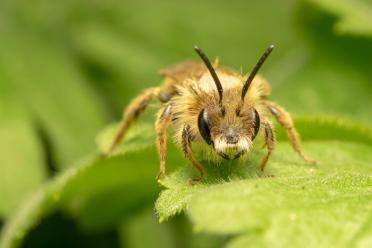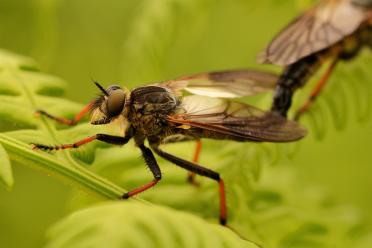Joined-up genetics essential to save UK pollinators
Our insects are in decline and under growing threat but comprehensive genetic sequencing and new farming regulations could mark a turning point.
Fewer species, falling numbers of individuals, and a shrinking of their ecological ranges - the consensus among UK experts is that our insects are facing a perfect storm.
The downward trend in insect numbers is showing across the board, including crucial pollinator species essential for helping farmers to meet the demands of our insatiable appetites.
The House of Commons Science, Innovation and Technology Committee recently published a report, Insect decline and UK food security, which the Earlham Institute contributed to through written evidence, jointly submitted with partners on the Norwich Research Park. The Government will respond soon to the policy recommendations made by the Committee.
The report investigates the value of insect diversity and the knowledge gaps we need to address, and explores some of the urgent and multifaceted approaches needed to safeguard their - and thereby our own - futures.
A more comprehensive study of invertebrate genetics - looking beyond pollinator species - could provide the kind of insight that, when paired with new agricultural reforms, could help reverse insect decline in the UK.

Green forester moth

Red mason bee

Pollen beetle
Dr Will Nash is a researcher in the Haerty Group at the Earlham Institute. He has devoted his career to understanding the relationships between pollinators and the environment.
His work focuses on bees, including the generation of high quality reference genomes - like that of the violet carpenter bee - and the study of ancient bee DNA taken from museum collections.
These genomic resources tell a story of pollinator evolution, adaptation to the impact of human activity, and the genetic health - or vulnerability - of the species. Studying insects present in the landscape today is vital to understanding current patterns and population trends.
From finding differences that define species to modelling fluctuations in the size of insect populations over tens of thousands of years, the insights gained from analysing invertebrate DNA are essential for informing contemporary conservation efforts.
While there has been plenty of buzz about bees over the years, Will says genetic resources for other pollinators are urgently needed.
“Until recently, we’ve simply not had the genomic resources we need to meaningfully understand the genetic health of pollinator communities in the UK,” he explains.
“If we want to understand the impact of human activity on the genetic diversity of our pollinators, we need reference genomes and large scale resequencing data so we can look across ecosystems and understand patterns of change over time.”
A lot of pollinators will only pay a visit to specific species of plants. With the ongoing decline in insect populations, these are niche relationships that other species won’t naturally enter into.
“This is not just about honey bees, or butterflies, or the classic species we think of,” explains Will. “It's about the biodiversity of our ecosystem - all the interrelated species.
“Their interactions are critical to the overall health of these environments.”


We need to translate the huge progress represented by large genome sequencing initiatives into an applicable understanding of pollinator genetics and its interaction with the way we grow our food.

There are more than 40,000 invertebrate species in the UK and all of them play different roles in our ecosystem.
While pollinators are key to food production, there are many other ways in which insects and other invertebrates contribute. They eat crop pests, maintain soil health, and recycle waste into nutrients.
Despite their value, they are often understudied and overlooked. As a result, we have underestimated the fragility of these ecosystems and the consequences of human activity on them.
For example, when we use pesticides to target species we regard as pests, such as aphids, these can also affect other insects.
“The impact of pesticides and other chemicals on non-target insect species remains poorly understood,” Will says.
“It’s difficult to differentiate the impact of large, landscape-scale effects - whether that’s agricultural practice, wider human activity, or the influence of climate change - on our insect fauna.”
He believes there is a need for extensive data collection to study the status of key species, the sustainability of their populations, and to help predict their future dynamics.

Common ladybug

Marmalade hoverfly

Hornet robberfly
The missing genomic resources and data gaps were highlighted in the House of Commons report and are an area where organisations like the Earlham Institute can make a major contribution.
The Institute’s multidisciplinary expertise in genetic resources and genomic analysis means techniques such as LITE pipelines are able to sequence entire genomes from minimal DNA samples.
“Often with insects you will have only a very small amount of DNA,” Will explains.
The Earlham Institute’s mission includes sequencing genomes to understand organisms better, as well as using advanced technology to explore relationships between species.

If we want to understand the impact of human activity on the genetic diversity of our pollinators, we need reference genomes and large scale resequencing data so we can look across ecosystems and understand patterns of change over time.

In the UK, 70 per cent of land is farmed, giving land managers a crucial role as custodians of these ecosystems and their insect biodiversity.
New government policies are being introduced that will include measures to better integrate wild areas with land used for food production and other commercial uses. The changes are part of the Agricultural Transition, the biggest shakeup to agricultural policy in the UK for decades.
Environmental Land Management Schemes (ELMS) are intended to support farmers in delivering beneficial environmental outcomes alongside their food production.
Farmers will be rewarded for adopting and maintaining sustainable farming practices to protect and enhance the natural environment.
But it is vital to monitor and progress ELMS to make sure they have the most impact. Making them work will require robust data on ecosystem health.
“Sustainable land management is predicated on equipping farmers with the resources and technology to understand and care for their land effectively,” says Will.
“We also need to translate the huge progress represented by large genome sequencing initiatives into an applicable understanding of pollinator genetics and its interaction with the way we grow our food.”
Dr Wilfried Haerty, Group Leader at the Earlham Institute, believes the technological advancements - including the speed, scale, and cost at which we can now sequence genomes, even with low input samples - put us in a position to make ELMS effective.
“We’re in a very exciting time,” he says. “Because of molecular biology and sequencing technology developments, we can not only assess the genetic status of current pollinator populations across a landscape but we can now interrogate the incredible historical collections housed within our museums.
“This allows us to reconstruct the genetic composition of past populations and - in association with historical records - reimagine their dynamics across major changes in land management and agricultural practices, whether that’s monocultures, intensification, or the introduction of pesticides.
“This in turn will provide the baselines to be able to predict the future sustainability of the pollinator populations.”

This is not just about honey bees, or butterflies, or the classic species we think of, it's about the biodiversity of our ecosystem - all the interrelated species. Their interactions are critical to the overall health of these environments.

Future strategies may involve training farmers to contribute to species sampling and using innovative methods like environmental DNA analysis for monitoring soil health.
Elsewhere, engaging the natural history community - including amateur naturalist groups - could provide valuable local knowledge and support broader conservation efforts.
Invertebrates play a fundamental role in UK food security and maintaining the overall health of many of our most treasured ecosystems. They are unquestionably deserving of our help.
The House of Commons report recommends the introduction of a ‘National Invertebrate Strategy’ to include non-pollinating, agriculturally beneficial invertebrates. The strategy would include an implementation plan linked to clear 5-year targets.
This would help to bring the academic and farming communities together to jointly develop a long-term and complimentary approach.
Will is supportive of the idea. “We have an amazing heritage of studying natural history in the UK, and the establishment of a National Invertebrate Strategy would be a great opportunity to build on this,” he says.
“We need to formalise an action plan to address widespread declines in invertebrate biodiversity across our ecosystems.”
He also sees real value in the House of Commons recommendation that the Government publish a National Action Plan for Sustainable Pesticide Use this year.
Non-pollinating insects are now firmly on the political agenda and, if the right action is taken - and taken swiftly - we will be able to reverse the decline and safeguard the health of our environments and food production.